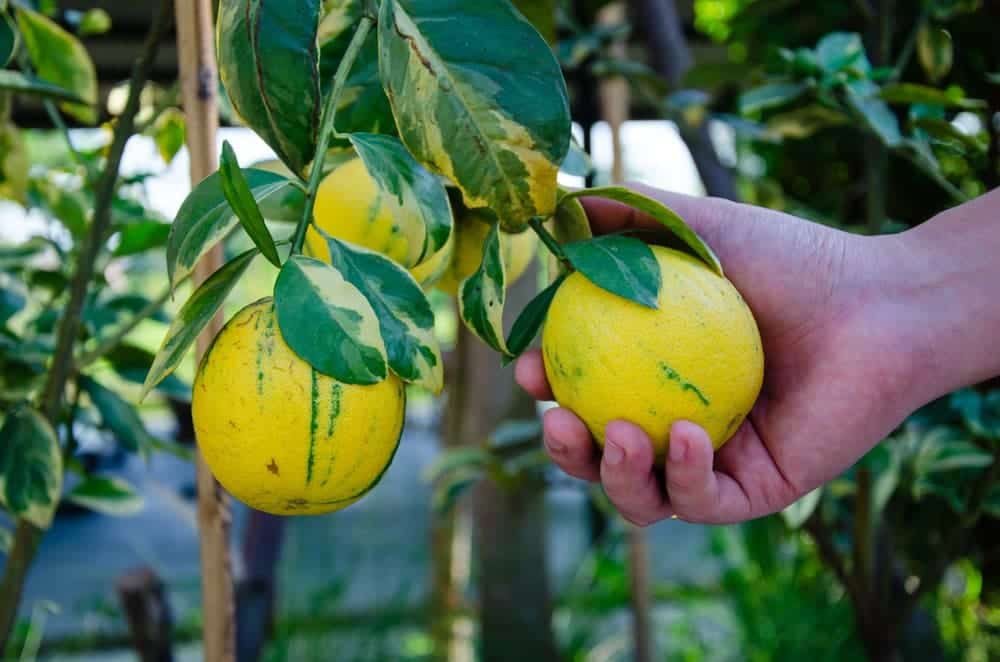The Eureka Pink Lemon tree yields delicious fruit and is very aesthetically pleasing. Both the tree’s foliage and the fruit it bears offer a colorful spectacle.
These trees aren’t particularly difficult to grow, but you’ll definitely need some basic information before getting started. This is a great choice for those who want to grow their own lemons at home.
Eureka Pink Lemon Tree Plant Care & Growing Guide
1. Light Requirement
Full sunlight is required to grow a eureka pink lemon tree. It is not recommended that you try to grow one of these trees in partial sunlight. This tree needs to get lots of sunlight on a daily basis (8 hours minimum) in order to grow healthy and bear fruit. If you are planning to grow inside, you’ll want to keep it by a window that receives direct sunlight.
2. Water
You will only have to water this plant every three days or so, as it is quite drought tolerant. While drip irrigation is the best option, you can also use a hose to provide it with nourishment. After a year, you will only have to water it every 8-10 days.
Keep in mind that you should water it more frequently when it is very hot. You should always feel the soil before watering this plant. Wait until the soil has dried out completely before giving it a drink.
3. Climate
This lemon tree can be grown in USDA hardiness zones 9 and 10. It does best in regions that are very sunny year round, such as Florida.
4. Soil
You should plant this tree in well-draining soil that has a pH between 6 and 8. You will be able to use pretty much any kind of potting soil. Avoid topsoil or gardening soil if you plan on growing this plant in a container.
Sandy or loamy soil is a good choice for these plants, as it drains nicely. This will greatly reduce the chances of your plant developing root rot. Clay soil is another good choice, particularly when it is combined with a bit of limestone. There are many different soil options available for this plant.

5. Temperature
While eureka pink lemon trees can withstand high temperatures, younger trees are somewhat vulnerable. If your tree hasn’t matured yet, temperatures in excess of 90 degrees Fahrenheit could cause the leaves to wilt.
Learn more: String of Hearts (Ceropegia) Care & Growing Guide
6. Repotting
When you are repotting one of these plants, you’ll need to be especially careful not to damage the root system. This is especially crucial if the roots are tangled at all. Transfer the plant into a slightly larger pot so the roots can spread out uninhibited. Fill the pot with fresh soil after putting the plant in the new container.
7. Speed of Growth
These trees grow fairly quickly, bearing fruit within a year.
8. Height and Spread
Eureka pink lemon trees can grow to a height of 15 feet with a spread of about the same. It is therefore important that you choose the right place to plant it. The last thing you want is for any other plants or trees to get in the way of its growth as it develops.
9. Flowers
This tree produces beautiful white flowers that are actually quite fragile. The citrusy fruit it also produces has a unique striped green skin. When the fruit starts forming, it will slowly take on a yellow coloration. When you cut the fruit open, you will instantly see a bright pink color that resembles grapefruit.
More like this: Hibiscus Tree Care & Growing Guide
10. Trimming
It will be necessary to prune your eureka pink lemon tree each year. Within the first three years of your tree’s life, you should trim enough to where there are only about five stout bearing limbs. You’ll also want to make a point to trim off smaller growth on the inside of the tree. Cut off any dead leaves right away as well.
How to Get Pink Lemon Trees to Flower
One of the best ways to get this lemon tree to flower is to provide it with adequate water. When these trees are still developing, they need a good amount of water on a regular basis. It’s also a good idea to use a fertilizer that is meant for citrus trees. You’ll want to lay down the fertilizer before spring hits.
Common Eureka Pink Lemon Tree Diseases
There is a fungal disease called postbloom fruit drop, which has been known to affect these lemon trees. You will notice lesions forming on the flowers of the leaves. The fruit will also start dropping off the tree. These lesions have an orange coloration and should not be ignored. An effective fungicide can treat this disease, provided it is not too advanced.
Root rot can also be a major problem with lemon trees in general. This is usually caused by overwatering. The best way to avoid this is to water conservatively, especially once the tree has fully matured.
Collar rot, brown rot, and lemon scab are some other common issues with these trees. It is important that you regularly apply a copper spray to the fruit on the tree to keep it clean.
Keep reading:
Conclusion
The eureka pink lemon tree offers a great addition to any backyard garden. It does require full sunlight on a regular basis, so it should not be grown in a shady spot. You’ll need to make sure that it gets plenty of water while it is still growing. Once this tree has matured, you won’t have to water it as often.
A loamy and/or sandy soil that drains well is perfect for these trees. This tree is fairly durable and can withstand high temperatures, but it is more vulnerable when it’s still developing.
This tree produces incredibly beautiful white flowers, as well as delicious yellow striped lemons that are bright pink on the inside. When it comes to encouraging flowering, you’ll want to use a good citrus fertilizer. Fungal diseases can be a problem with these lemon trees, so you’ll want to look out for the signs. Make sure that you do not overwater this tree, as root rot can take hold very quickly.
Also read:
- Sweet Almond Bush: Plant Care & Growing Guide
- African Bush Daisy (Euryops Chrysanthemoides): Plant Care & Growing Guide
- Gerbera Daisy Care & Growing Guide
Victoria is the owner and main author of hobby plants. She loves spending her free time in her garden planting and taking care of her plants. Victoria hopes you enjoy the content here!

![How Do You Propagate a Money Tree? [COMPLETE GUIDE] How Do You Propagate a Money Tree? [COMPLETE GUIDE]](https://www.hobbyplants.com/wp-content/uploads/2022/06/how-to-propagate-money-tree-300x158.jpg)
![Best Soil For A Money Tree? [DIFFERENCES EXPLAINED] Best Soil For A Money Tree? [DIFFERENCES EXPLAINED]](https://www.hobbyplants.com/wp-content/uploads/2022/08/best-soil-for-money-tree-300x158.jpg)
![Mother Of Thousands Plant [Complete Plant Care Guide] Mother Of Thousands Plant [Complete Plant Care Guide]](https://www.hobbyplants.com/wp-content/uploads/2022/07/mother-of-thousands-plant-300x158.jpg)
![Majesty Palm Plant Care: [Complete Beginner's Guide] Majesty Palm Plant Care: [Complete Beginner's Guide]](https://www.hobbyplants.com/wp-content/uploads/2022/08/majesty-palm-care-300x158.jpg)
![Exotic Angel Plant Care: [Complete Beginner's Guide] Exotic Angel Plant Care: [Complete Beginner's Guide]](https://www.hobbyplants.com/wp-content/uploads/2022/08/exotic-angel-plant-care-300x158.jpg)
![Snow White Waffle Plant: [Complete Care Guide] Snow White Waffle Plant: [Complete Care Guide]](https://www.hobbyplants.com/wp-content/uploads/2022/08/snow-white-waffle-plant-300x158.jpg)
![Waffle Plant Care: [Complete Beginner's Guide] Waffle Plant Care: [Complete Beginner's Guide]](https://www.hobbyplants.com/wp-content/uploads/2022/08/waffle-plant-300x158.jpg)
![Bird Of Paradise Plant Care: [Complete Beginner's Guide] Bird Of Paradise Plant Care: [Complete Beginner's Guide]](https://www.hobbyplants.com/wp-content/uploads/2022/08/bird-of-paradise-plant-300x158.jpg)
![Purple Passion Plant Care: [Complete Beginner's Guide] Purple Passion Plant Care: [Complete Beginner's Guide]](https://www.hobbyplants.com/wp-content/uploads/2022/08/purple-passion-plant-care-300x158.jpg)
![China Doll Plant Care: [Complete Beginner's Guide] China Doll Plant Care: [Complete Beginner's Guide]](https://www.hobbyplants.com/wp-content/uploads/2022/09/china-doll-plant-care-300x158.jpg)
![Polka Dot Plant Care: [Complete Beginner's Guide] Polka Dot Plant Care: [Complete Beginner's Guide]](https://www.hobbyplants.com/wp-content/uploads/2022/09/polka-dot-plant-300x158.jpg)